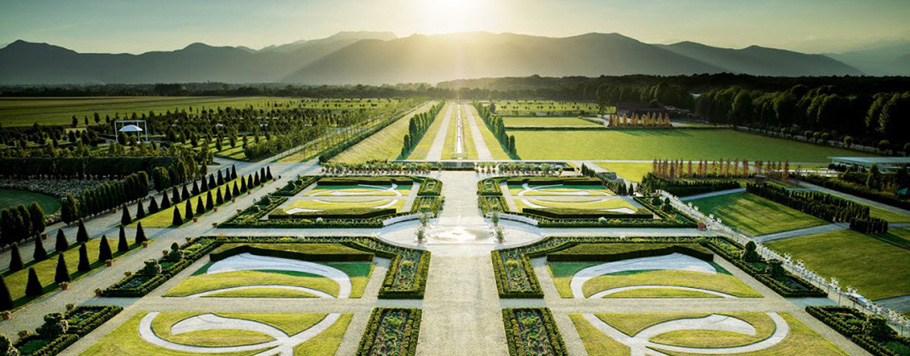 un progetto di
un progetto di 
La Reggia di Venaria Reale è una delle Residenze Sabaude costruita tra il 1658 e il 1699. A commissionarla fu il duca Carlo Emanuele II che intendeva farne la base per le battute di caccia nella brughiera collinare torinese; essa venne ribattezzata "la Venaria" perchè destinata agli svaghi venatori e i lavori vennero affidati all’architetto Amedeo di Castellamonte. Il complesso è molto imponente, comprende: il palazzo, il parco, i boschi di caccia e un intero borgo. La residenza fu progettata insieme con i giardini all’italiana con fontane, terrazze su più livelli, roseti, ecc. Dal 1699 l’architetto Michelangelo Garove riprogetta la Reggia per volere di Vittorio Amedeo II che la desiderava più imponente; anche i giardini furono ripensati alla francese su modello di Versailles. Nel 1716, l’ormai re, affida il progetto di ampliamento a Filippo Juvarra che creò la Galleria Grande, la Cappella di Sant’Uberto, la Citroneria e la Scuderia tutto in stile barocco. La Reggia venne trasformata in caserma all’inizio dell’Ottocento, con l’arrivo di Napoleone, la fuga e il ritorno dei Re Savoia; tolto il presidio militare divenne luogo abbandonato e vandalizzato. La Reggia di Venaria Reale è stata dichiarata Patrimonio dell’Umanità dall’Unesco nel 1997 e ha aperto al pubblico nel 2007 dopo un restauro tra i più importanti d’Europa.
The Reggia di Venaria is one of the Savoy residences built between 1658 and 1699. A commissionarla was Duke Carlo Emanuele II who wanted to make it the basis for the hunt in the hilly Turin heath; it was renamed the "Venaria" because intended for hunting leisure and the work was entrusted to the architect Amedeo di Castellamonte. The complex is very impressive, includes: the palace, the park, the woods hunting, and an entire village. The residence was designed together with the Italian gardens with fountains, terraces on different levels, rose gardens, etc. From 1699 the architect Michelangelo Garove redesigns the Palace by the will of Vittorio Amedeo II, who wanted more imposing; Also the gardens were redesigned French modeled on Versailles. In 1716, the now King, entrusted the project to expand to Filippo Juvarra who created the Great Gallery, the Chapel of St. Hubert, the Citroneria and Scuderia all in baroque style. The Palace was transformed into a barracks at the beginning of the nineteenth century, with the arrival of Napoleon, the flight and the return of the Savoy King; It removed the garrison became a place abandoned and vandalized. The Reggia di Venaria was declared a World Heritage Site by Unesco in 1997 and opened to the public in 2007 after a restoration of the most important in Europe.
Contatti
Reggia di Venaria Reale
Piazza della Repubblica, 4
10078 Venaria Reale (TO)
Informazioni Generali
E-mail: prenotazioni@lavenariareale.it
Web: lavenaria.it